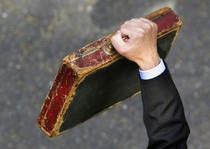 Little did I imagine, when I calculated that the Tory spending parameters would involve a 10 percent cut in non-NHS departments, that it would attract such an audience. Brown repeaed it on Marr, as if it were an official Tory figure. But when Andrew Lansley mentioned it this morning as an official Tory figure then, I guess, it becomes Tory policy. A great battle ensured in PMQs: whose cuts are they? Tory cuts or Labour cuts? Real or fake? Brown loves such battles, thinking that no journalist can be bothered to go do the maths by themselves. He will be wrong here, I suspect, as the maths is pretty easy.
Little did I imagine, when I calculated that the Tory spending parameters would involve a 10 percent cut in non-NHS departments, that it would attract such an audience. Brown repeaed it on Marr, as if it were an official Tory figure. But when Andrew Lansley mentioned it this morning as an official Tory figure then, I guess, it becomes Tory policy. A great battle ensured in PMQs: whose cuts are they? Tory cuts or Labour cuts? Real or fake? Brown loves such battles, thinking that no journalist can be bothered to go do the maths by themselves. He will be wrong here, I suspect, as the maths is pretty easy.
Budget 2009 proposed total real-terms spending falling by 0.1 percent a year for three years starting April 2011. Those figures Brown read out in PMQs represent a real-terms cut as any half-sentient economist will tell you. The IFS spotted the complete trick the day after the Budget. Factor in the rising cost of debt interest and it implies that public service spending will fall by 2.3 percent a year. This makes a cumulative 6.7 percent over those three years. This is what Labour proposes to do if it wins the next election.
The Tories have (until today) given no figures – but they won’t spend more than Labour so their cuts will be at least as harsh. But David Cameron has indicated that he’d increase health, meaning that the burden will fall more sharply on other department. In effect, this means cuts of 3.2 percent a year, for those three years – so a cumulative 10 percent. Crucially, this is a Labour cut, determined by the cuts spelled out in Budget 2009. Brown thinks he will win this debate, as the Tories will be honest about cuts – demonstrated by Lansley this morning – whereas he will be dishonest.
So how is Labour spinning this? They have two methods. One is to dress up the nominal rises as real-terms increases – as Brown did in PMQs today. The other is the device which Darling was made to use in the Budget speech and Liam Byrne used yesterday. They say “current spending” is going up by an average 0.7% a year over that period. This is a definitional trick, as it excludes what Brown categorises as “investment” spending in public services which is due to fall from £44bn to £22bn. I reprint the budget table showing that below. So, behold, on the bottom line, the cuts:

The only difference between Labour and the Tories is that the Tories would spare health. Brown’s axe might fall anywhere. What happens now will be interesting, in terms of shaping British political debate. Pre-blogging, the could get away with Brownies like this. No newspaper would bore its readers with the space to Fisk him properly. He could mislead, as long as the fib was expressed in a figure. But in the internet age, his tricks can stand exposed for what they are: an attempt to conceal from the British public the cuts that he plans for public services should he win an election.
The Institute for Fiscal Studies will confirm all of the figures above: it is their maths, not mine, that unearthed the truth from Budget 2009. So far, this attempt has succeeded. No newspaper currently talks about the cuts Labour proposes post-election. Let’s see how long that lasts for.
UPDATE: Thanks for the comments below; many raise important points. Here is my response:
Fred: the cuts I mention are investment. It’s just a small part of the total. Total spending = ‘current spending’ + ‘investment’ + depreciation.
Peter Buss: Darling claimed in his budget speech that frontline services will be protected, but he hasn’t published a breakdown to his cuts so we just don’t know where Labour’s axe will fall.
Michael Sweeney: You’re right, the separation between ‘current spending’ and ‘investment’ can be tenuous – but in a nutshell: total spending is falling slightly, and when you count higher debt interest and welfare bills this means public services are falling sharply.
Tenpin: I really don’t care whose hands I play into. My remit is to give CoffeeHousers the unvarnished truth.
Fraser/Luke: no, I don’t think 10% will be enough cuts. I think it is a bare minimum and Cameron will be forced by the credit rating agencies to do more like 15% if he wants to start reducing the debt/GDP ratio as he claims. (Roger, I’m still working on it).
Dorothy: Woolas is talking out of his hat. Public spending is falling after the election, no matter how you define it, no matter who you elect.
Nicholas: yes, a staggering own goal by Lansley. He should never have repeated that 10% figure, even if he did get it from, ahem, an impeccable source.
Toby: I hear your point but I am just repeating what the Budget says. It’s their definition of ‘net investment’, not mine.







Comments